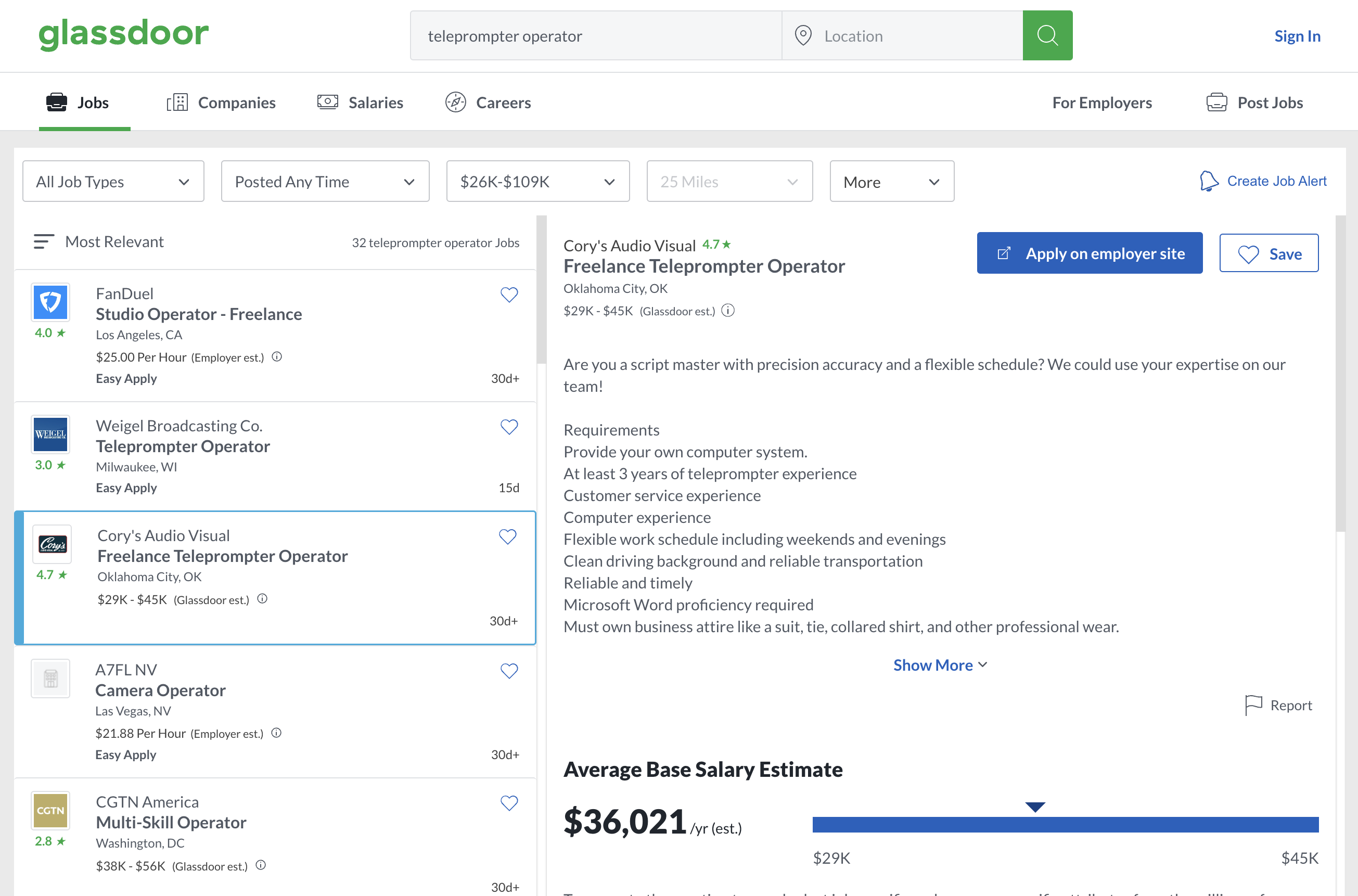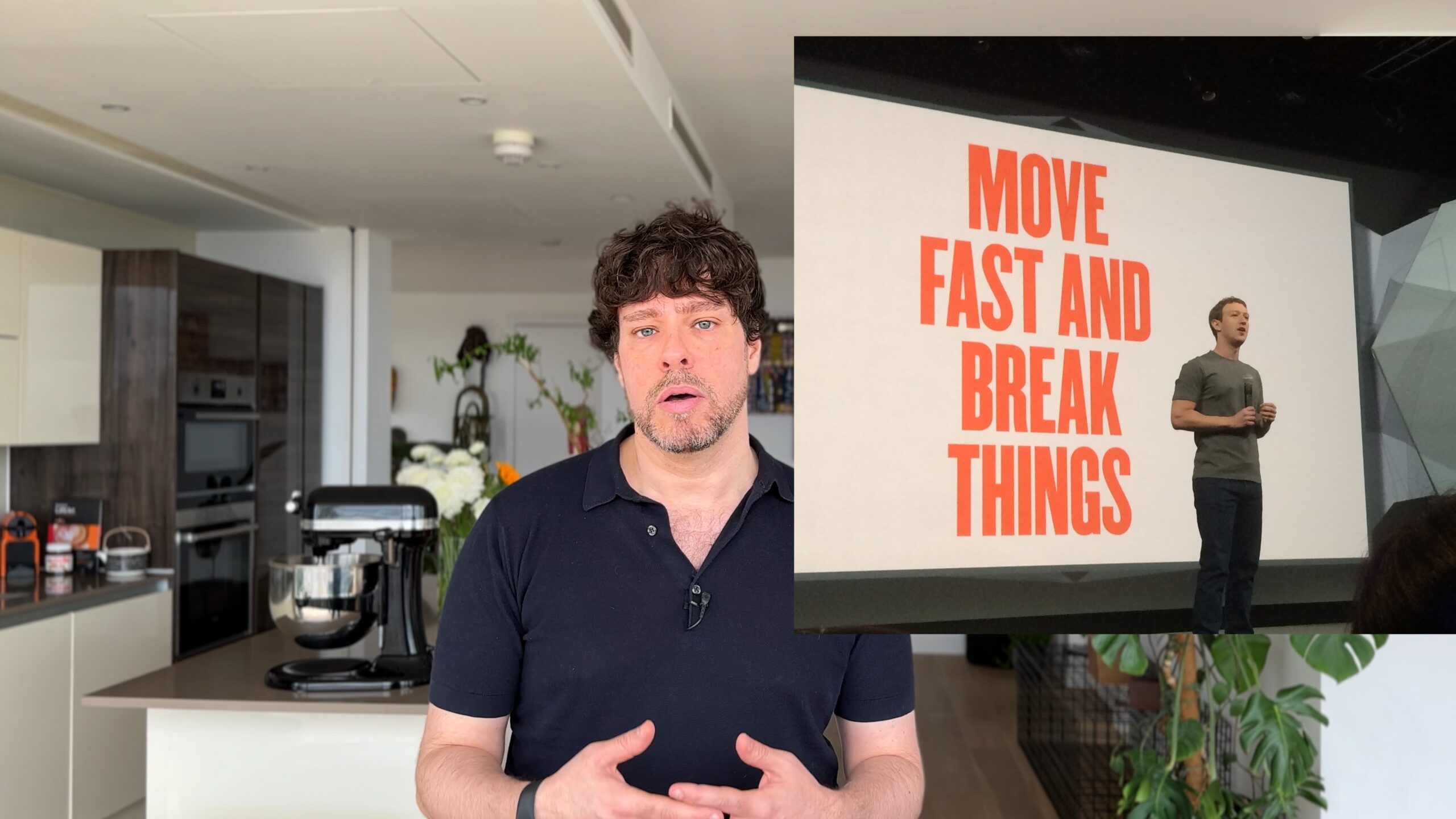
- HSBC launches a new AI-powered index. It looks a lot like the old one, let’s hope the performance is better.
- Aberhart Farms has been testing drones for weeding for years. Probably because it’s very fun.
- 88Nine Radio Milwaukee is using AI to power an experimental radio station. The human radio host still doesn’t suspect anything.
- How to use The
AnnoyingCurious Child prompting technique to get more detailed outputs from GPT-4 - My favourite teleprompter app and why AI makes it stand apart from an ocean of terrible alternatives
Let’s celebrate this second month of Synthetic Work with some changes.
Change 1: The Section “If You Only Have a Hammer…” is now renamed “The Tools of the Trade”.
Change 2: Starting today, the Splendid Edtion will not dedicate each week to a single topic, but will have something about each and every section. Same content, just a different way to present it. You’ll understand better why below. Let me know if you like this format better or not.
Change 3: Splendid Edition members get a new perk: access to a new database sort of called The Best AI-Centric Tools for X or, more colloquially, Best For.
This database will list what I consider the best AI-centric tools/products/services to do specific tasks across multiple lines of work. It will describe why I think AI is making a difference and why these tools are better than their (listed) alternatives.
I’ll keep the database regularly updated. You can see an example of the content here. It’s a work in progress.
While I’ll mention the tools in the database in The Tools of the Trade section, you won’t receive the database updates via the Splendid Edition newsletter. It’s too impractical to deliver that kind of structured information over email.
You’ll just have to browse Synthetic Work website whenever you need it.
Notice that this database is not organized by product, but by tasks that you want to accomplish. Differently from the large majority of people I’ve met in the IT industry in more than two decades, I believe that customers (me included) reason in terms of problem-to-be-solved or job-to-be-done rather than “Oh I totally should pay attention to random product X from company A that all of a sudden appeared in my inbox and that I care absolutely nothing about and have zero time to dedicate to”.
I’m doing this for three good reasons:
First. You asked. Customers are my number one concern in business, so I listen very carefully to the feedback I receive from all of you.
Second. As some of you know, I try practically every new tool that hits the market (and not just about AI), often before everybody else. And this equally applies to free personal productivity tools and multimillion-dollar enterprise software. In fact, during my tenure in Gartner almost 10 years ago, I was one of the very few research directors installing and trying uber-complicated enterprise IT management and automation suites.
If you don’t try the products first-hand you cannot understand intangible dimensions like the level of friction in the interaction or the emotional response, which end up shaping the user experience into the make-or-break factor that it is.
I spend an insane amount of time searching, testing, and comparing products to be sure that my choices are informed by my selection criteria in terms of quality, capabilities, and level of friction, rather than the hysterical hype of a mass of young engineers.
I’m happy to share the outcome of this time-consuming process with the esteemed members of Synthetic Work.
Third. The aforementioned hysterical hype of a mass of young engineers is causing so much noise that it’s becoming impossible to discern what is good and useful and sustainable from a business standpoint from what is a script that has been hacked in a night and will disappear in one month.
If you don’t know what I’m talking about, lucky you. You can have a taste of this by looking at the entire thread below:
What a time to be in tech. pic.twitter.com/xOx0V8wMgM
— Chris Albon (@chrisalbon) April 19, 2023
In the overwhelming majority of cases, these tools/products/services don’t even have a defensible competitive advantage which means that they will be crushed by the competition of hundreds of clones and you, trusting your business on them, will be screwed.
As everybody has equal access to GPT-4 by OpenAI or the upcoming StableLM by Stability AI, the business moat cannot be a massaged prompt before the user’s one and a sleek user interface to hide it. We said it many times in this newsletter.
So how are you going to pick a decent tool for the job? You could trust an online website, of course. Except that almost all of them are ad-sustained businesses, and many, secretly, are pay-to-play.
Here’s an example I received in my inbox this week:

Let me know what you think about this new perk and submit the tasks you want some product suggestions for.
By the way, we’ll have another two databases going forward: one about prompting techniques and one about how your peers are using AI in your industry (Education, Finance, Government, Health Care, Media & Entertainment, Tech, etc.).
So, basically, one for each section of the Splendid Edition newsletter.
And now, finally, let’s get to the content of the week.
Alessandro
What we talk about here is not about what it could be, but about what is happening today.
Every organization adopting AI that is mentioned in this section is recorded in the AI Adoption Tracker.
Just like we do with the What Caught My Attention This Week section of the Free Edition, let’s go for three updates:
In the Farming industry, Aberhart Farms is testing AI-powered drones to kill weeds. Coco Liu reports the story for Bloomberg:
For the past three years, Terry Aberhart has watched the spindly, fixed-wing drones zip across the big skies over his farm in Canada’s Saskatchewan province, testing a technology that could be the future of weeding.
Fitted with an artificial intelligence system, the drones are designed by local startup Precision AI to spot, identify and kill the weeds without drenching the entire crop in chemicals.
…
Apart from the environmental toll, that conventional spray-it-all approach also results in colossal financial waste. Aberhart spent nearly C$1 million ($745,000) on herbicides in 2022 alone to protect the wheat, canola and pulses growing on a slice of prairie larger than Manhattan. “Even if we could save 50% on average, it’s a huge saving,” he says.
…
Precision AI is among a handful of companies turning to advanced technology to address the problem of chemical overuse in agriculture. Founded in 2017 by serial tech entrepreneur Daniel McCann, the company uses images of 15,000 plant species to train computer algorithms to distinguish staple crops (think corn, wheat and soybeans) from unwanted weeds. The drone’s camera can “see” anything bigger than half a sesame seed and its AI identifies weeds with 96% accuracy, spraying the intended target alone.
…
Precision AI says its approach can reduce herbicide use by as much as 90% compared to traditional methods.
…
For now, Precision AI’s drone is operated with supervision from a human pilot. But McCann says his company is poised to introduce a fully autonomous spraying drone that can take off, fly and land by itself – as long as regulators grant permission.
…
Aberhart, the farmer in Saskatchewan, says it will require “a big shift in mindset and mentality” for the farming community to switch over from the blanket spraying practice that has dominated the industry for decades. The first converts will be taking a big risk. After all, if weed management fails, it can ruin a season.

Brace yourself for the unmissable comment that somebody will make: “Every farm will become a tech company.” or something cringy like that.
–
In the Finance industry, HSBC has launched a new AI-powered index. From the press release:
HSBC today announced the launch of the HSBC AI Global Tactical Index (HSBC AIGT), which will use machine learning powered by Amazon Web Services, Inc. (AWS) in conjunction with equity investing.
…
HSBC AIGT uses AWS AI services to analyze and learn from data thousands of times faster than humans, enabling the index to automatically adapt its approach as market dynamics change and new information becomes available.Ibexis Life & Annuity Insurance Company (Ibexis), a provider of retirement savings products, is the exclusive provider of HSBC AIGT in its suite of fixed indexed annuities. Applying what has been learned, HSBC AIGT employs a rules-based investment strategy that uses advanced techniques in AI and machine learning to opportunistically invest across a global portfolio of assets. HSBC AIGT rebalances its portfolio weekly, and, to manage short-term volatility, reallocates among the chosen portfolio and cash on a daily basis. HSBC AIGT dynamically shifts in and out of global equities, gold and bonds in an attempt to provide a combination of equity capital appreciation, inflation protection, and stable fixed income returns.
In reality, this thing was released in February, but perhaps nobody noticed so let’s do a press announcement.
Also, AIGT sounds exceptionally similar to another AI-powered index called AiMAX, launched in April 2021 with two different partners: IBM and Athene USA.
The press announcement has disappeared, but we got Google cache to help us:
HSBC today announced the launch of the AI Powered Multi Asset Index (AiMAX) family, the first rules-based multi-asset investment strategy to use artificial intelligence (AI) as a method for constructing a diversified growth portfolio.
The introduction of AiMAX follows HSBC’s launch of AiPEX, the world’s first AI-powered stock index family using IBM Watson. Since going live on August 9, 2019, the AiPEX Total Return Index (AIPEXTR) has outperformed the S&P 500 Total Return Index by 4.79 percentage points.
AiMAX was developed in collaboration with EquBot, the first asset manager to develop an AI-based ETF, and utilizes IBM Watson Discovery to retrieve and analyze millions of data points, from both traditional sources such as financial statements and non-traditional sources such as social media posts.
…
HSBC is the exclusive licensor of AiMAX and AiPEX, and is offering a variety of investment solutions based on the indices to its clients globally. Athene USA, a leading provider of retirement savings products, now offers AiMAX and AiPEX in its suite of fixed indexed annuities.
How did AiMax really perform? You can use a lot of tricks to make it look good, and HSBC certainly does it on the product page, but if we look at AiMax’s performance since they started the real-time calculation, January 26, 2021, we see a -5.77% compound annual return.
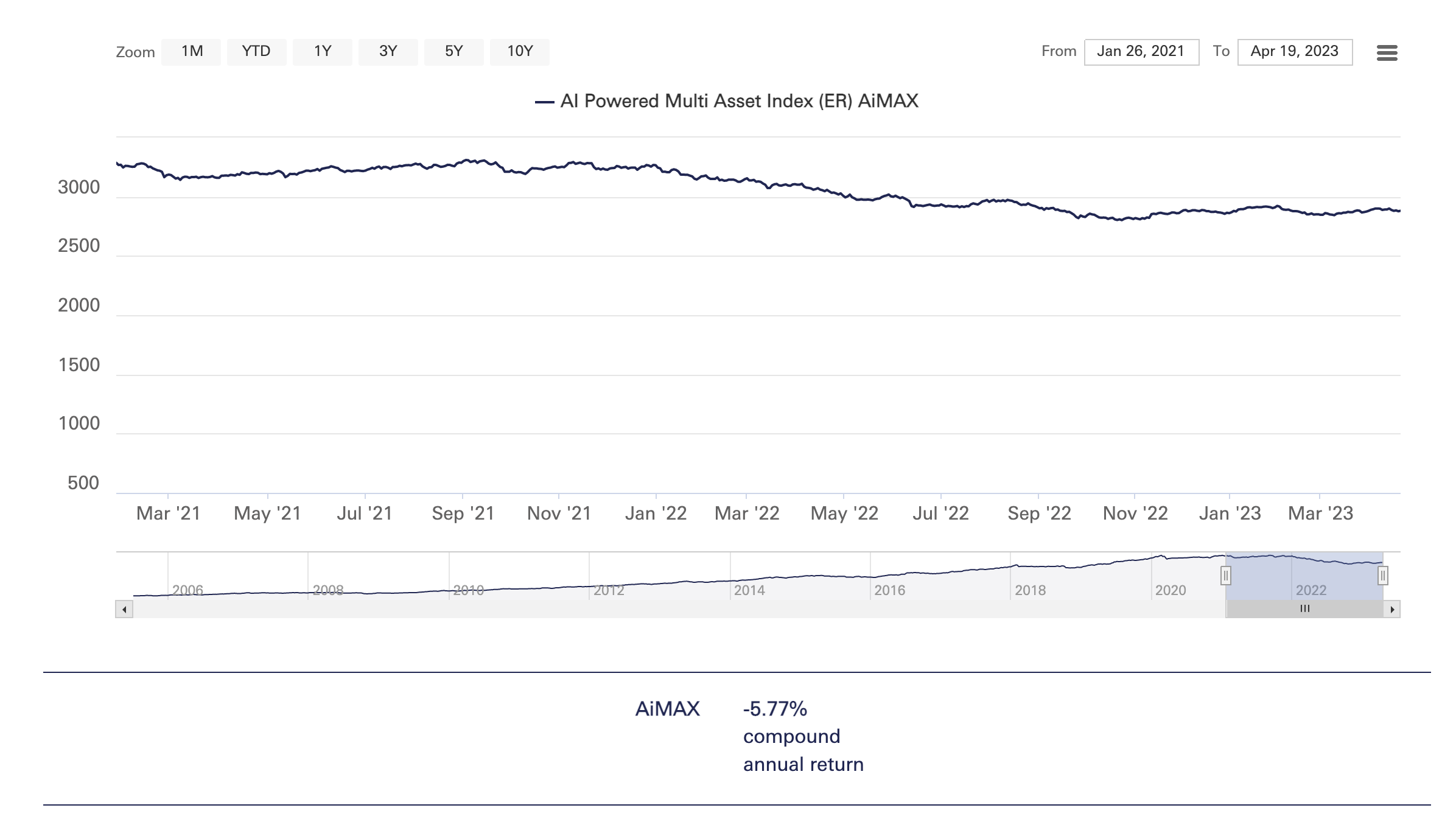
Not inspiring.
The Finance industry will likely be the most impacted by the most recent progress in AI, and we start to see the first steps with the announcement of the generative AI model BloombergGPT. But these AI-powered indexes are not it.
–
In the Media & Entertainment industry, 88Nine Radio Milwaukee (WYMS-FM 88.9), is now using Super Hi-Fi technology for AI-powered radio programming.
Super Hi-Fi’s product, called Program Director, uses artificial intelligence to generate the music playlist that will be broadcasted, like Spotify and other music services do (poorly) to suggest songs we might like next, and to automatically adjust volumes and fading of each song and each radio host segment without the need of complex mixing the tracks.
More importantly, Super Hi-Fi, in turn, has partnered with ElevenLabs, one of the top startups on the market for the production of synthetic voices (aka Text-To-Speech or TTS).
So, now, their Program Director uses GPT-4 to generate interesting and relevant things to say about the song that is about to be broadcasted, and ElevenLabs’ technology say those things with original voices (rather than clones of existing voices) as a synthetic radio host.
For now, Radio Milwaukee is using this technology in an experimental radio show called Rhythm Lab Radio.
Now, class, can you tell me how many jobs are impacted by these four paragraphs?
Before you start reading this section, it's mandatory that you roll your eyes at the word "engineering" in "prompt engineering".
Last week, in Issue #8 – The Harbinger of Change, we introduced this new section of the Splendid Edition and explored a number of prompting techniques to increase the quality of the AI output.
The Prompting section has been received in a very positive way, so let’s continue on this track.
Behave like an annoying curious child
There are many ways to extract knowledge from the AI, depending on how much information you want to receive in your answers. Sometimes you want a straight-to-the-point answer with no verbose preamble, and sometimes you want a very detailed answer.
When you want a very detailed answer, especially if you are exploring a subject you are not familiar with, or you are brainstorming, you might benefit from learning the logic that links together the various pieces of information that compose the answer you are getting.
One way to get that is through a technique I call The Annoying Curious Child. Researchers sometimes call it Self-Ask, but my name is way better.
Let’s say that we are about to prepare a business plan for a new product launch. Rather than mechanically follow the best practices of how to write a business plan, maybe filling a template generated by GPT-4, we might want to reason on what matters to write in a business plan.
So we look for inspiration from the past:
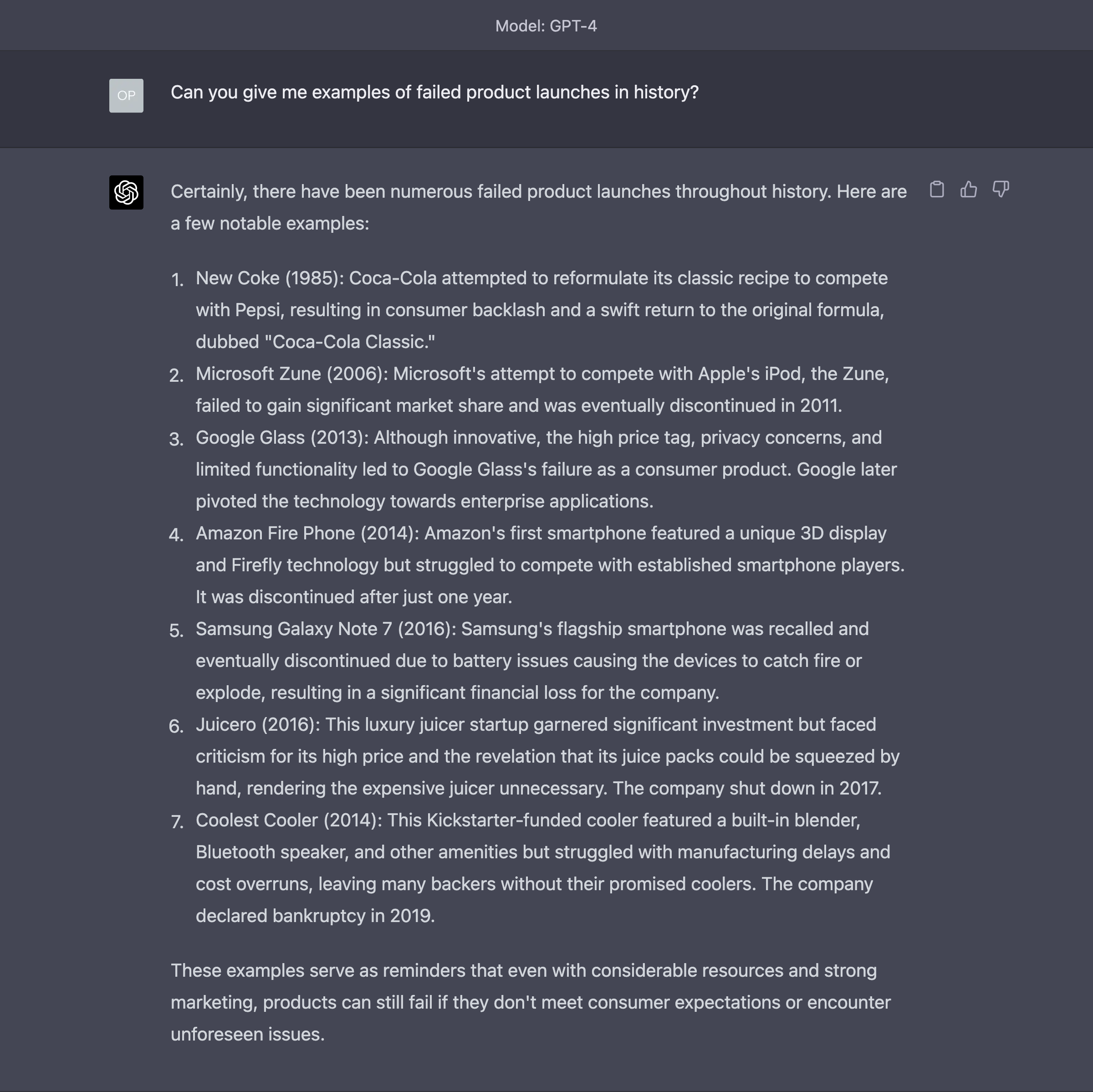
OK. I’m sure that we could get a much more articulated answer by asking for one, but we are trying to accomplish something specific here. So let’s invoke the help of The Annoying Curious Child:
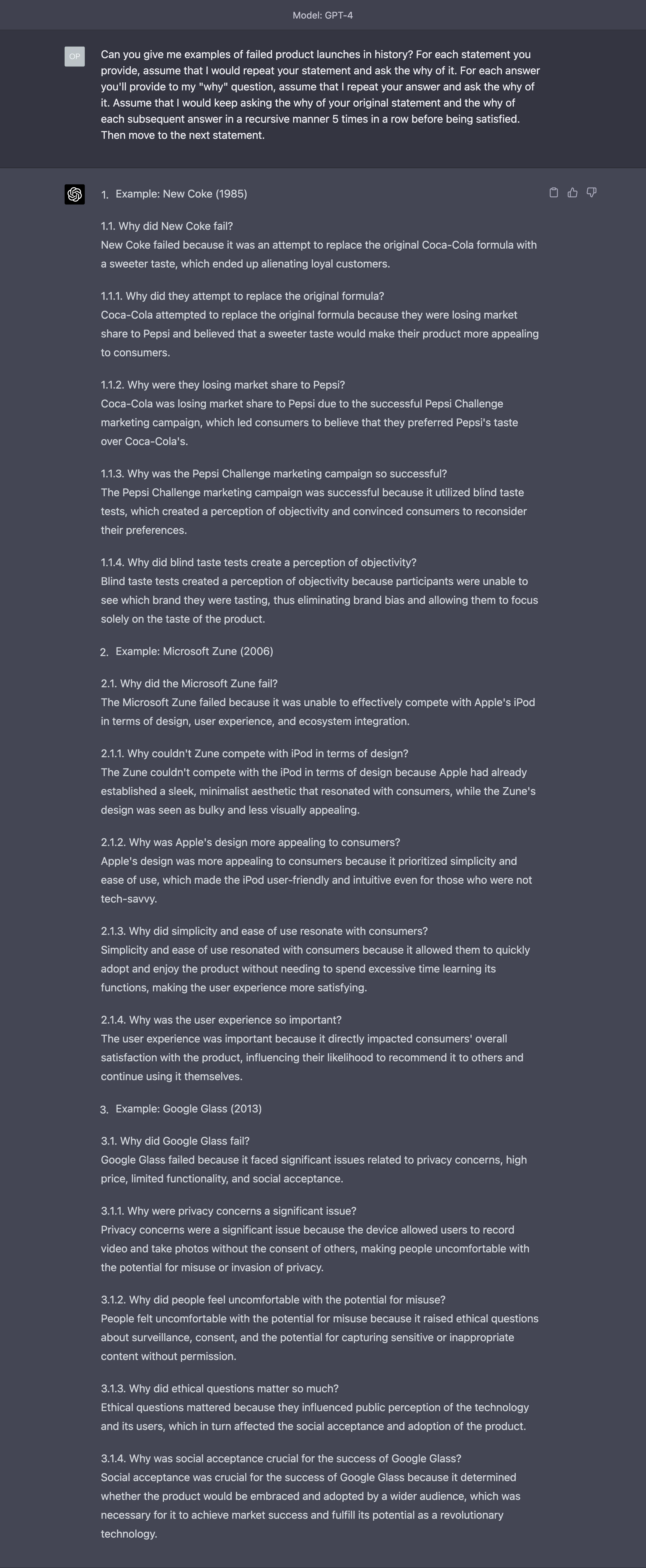
For the parents reading this: isn’t it satisfying to be able to inflict on somebody else what you had to endure for years? Sort of karma rebalancing exercise.
Of course, we could have asked the why in a manual way rather than by automating the recursion. It’s a trade-off: if we do it manually we are able to steer the conversation as we see fit and, potentially, get even longer answers; if we do it automatically, we save a lot of time.
Also notice that GPT-4 has, for now, some issues with the length of the answers. The first version of our prompt got back five failed product launch examples. But when we asked for the why of things, we only got three answers.
The AI lost its patience just like parents in real life. Adorable.
In Issue #7 – How Not to Do Product Reviews, I listed the ten products with some AI capabilities that I use the most during my day-to-day. The intent was to publish a short product review of each of them, but the conversation derailed toward competitive strategy, product differentiation, and other higher-order topics. So I could only talk about two of them.
In the meanwhile, as you’d expect, more of my favourite tools are gaining exciting integrations with the OpenAI platform, and so that top ten already needs to become a top eleven with some significant revisions.
Now you understand why we need the Best For database. If you want to know what I consider the best product for X, it’s hard for you to chase what I said across five newsletters and hard for me to update.
So let’s continue our exploration of that list, which now looks like this:
- GPT-4
- Perplexity
- Prompt+
- Descript
- Uncanny Automator Pro
- BTT
- Stable Diffusion
- Pixelmator Pro
- ElevenLabs
- Grammarly
- Fig
Today we talk abt Prompt+.
At the beginning of 2023, I started doing something that I always detested: recording videos of myself.
I never had any problem talking on a stage in front of audiences of thousands of people, and in fact, I did it for 20 years in a row, or giving interviews in front of a camera. But, for some reason, the idea of talking alone in a room, staring at a camera, is the most awkward thing in the world for me.
In late February, a publisher in Italy approaches me to discuss a collaboration for a regular, weekly series of video podcasts called Le Voci dell’AI. After sharing all my doubts and the reasons why I thought I would be a disaster at that, and after hearing each and every reason being refuted, I agree to give it a go.
Big mistake.
Here starts a descent into an infernal new world. An impenetrable maze of cameras, wireless microphones, softboxes, audio engineering, color grading, bitrates, and a gazillion of other things that I wish I never had to learn in life.
Among the others, the task required to master the domain I’ll call Teleprompter. Which really is two things.
One is the physical apparatus that holds the camera and a device with the text you want to read. A non-trivial subject that will lead you to learn things like camera mounts, and hot and cold shoe adapters, and beamsplitter glass size, and too much more.
The other is the software that actually scrolls the text you read while you are being recorded. And that’s where we fix our gaze on today.
My beloved iPad Pro 12′ works just perfectly for the job, but finding the right teleprompting app for it has proven to be a time-consuming effort.
Normally, teleprompting apps scroll the script to read automatically, at a certain speed (in terms of words per minute) that you set up. You can increase or decrease the speed with a Bluetooth remote control that you hold in your hand while you talk (or that is operated by an assistant).
Finding the right scrolling speed is very time-consuming and, since the speed is uniform, it leaves no room for creativity like dramatic pauses or a faster recital of certain passages. All of this must be done, with great effort and a lengthy post-production process, in the video editing software.
I hated that.
I also hated how buggy the teleprompter app that came with the teleprompter equipment was. And I also hated that the remote control that came with the teleprompter equipment was not compatible with third-party teleprompter apps. But I mainly hated the fixed scrolling thing.
There was a lot of hating going on, so I set out to find a teleprompter app that could do things differently.
And here I found an ocean of teleprompter apps polluting the App Store. Obviously, one favourite by most reviewers, the one apparently used by journalists across all TV networks, was not even close to what I wanted. It’s never that easy for me.
After dozens of trials, I finally found Prompt+.

This app stands a mile apart the others for a reason that, surprisingly, is barely advertised by the company that produces it: AI.
Norton Five Ltd, the software house that makes Prompt+, has leveraged AI to offer a unique feature: voice-activated scrolling.
In this modality, the app enables the microphone of my iPad to listen to my voice, does in real-time an operation called voice transcription or speech-to-text (STT) and, when it recognizes that I have said a sentence in the script, it scrolls it forward.
Liberating.
Prompt+ is incredibly fast and relable (but you need to have an iPad with Apple Silicon chips) and, to my surprise, it recognizes 50 languages, including Italian. Le Voci dell’AI is a podcast in Italian, so that made my use case even more complex.
I suspect that, especially with the recent capability to recognize 50 languages, Prompt+ is using Whisper behind the scenes.
Whisper is voice recognition AI model that OpenAI released as an open source project in September 2022. It features voice recognition and almost-real-time translation that is far superior to anything that exists on the market today.
Thanks to the open source release, people are incorporating Whisper in every video editing software out there as we’ll see in a future Splendid Edition.
There are other, very important reasons why Prompt+ is my teleprompter app of choice, but they are not related to AI, so this is not the context to talk about them.
If you want to see how well it works, you just need to watch one of the last episodes of Le Voci dell’AI. If you don’t understand Italian, it doesn’t matter. Just watch how comfortably I pretend to know what I’m doing.
Prompt+ is a prime example of how AI is improving the quality of the work we do, but also how it might impact the job market.
As I mentioned before, in my exploration of this new world of video production, I discovered that there are people whose job is to change the teleprompter speed in real time to adjust to the pace of the speaker. Soon, that task will not exist anymore.
